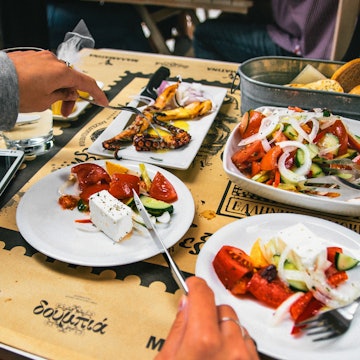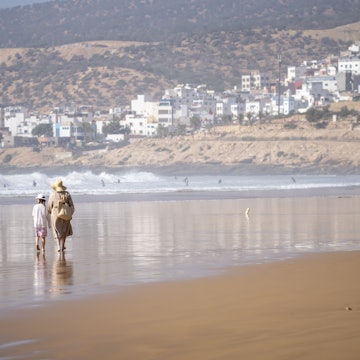
Slow down, take it easy – exploring a simpler way of life in the historic villages of Korea’s Gyeongbuk region
Nov 2, 2020 • 8 min read

Morning fog in Seongju © Gyeongsangbuk-Do Culture and Tourism Organization
Many times, when we travel, not only do we pack for the trip, but we also pack a long checklist of things to do and see once we get to our destination.
This must-do checklist drives us to rush from one place to the next and cram as many experiences into each trip as possible. Sadly, our focus becomes completing the list, and at the end of the holiday we are often unsatisfied knowing that by doing too much we did not pause to truly savor the destination. In South Korea, a few hours southeast of Seoul, are two 16th century-built villages that offer the refreshing opposite to the cosmopolitan city’s manic pace and way of life. Formally known as Gyeongsangbuk-do, the villages of the Gyeongbuk offer a chance to see how life was lived generations ago in a simpler time and where visitors slow down and take it easy.
To understand the way of life of Korea today, one must learn about its past – in particular, the Joseon period from the 14th until the 19th century. After repelling invasions by the Manchu and Japanese in the 1600s, the peninsula became isolated and was thus referred to in the west as the Hermit Kingdom. However, during this period, Korea saw 200 years of peace leading to prosperity, cultural and technological advancements. This was the golden era where Korean society embraced Neo-Confucianism ideology and where much of the current-day Korean traditions, culture, etiquette, and norms, as well as the language and the written word, were established.
Villages were established across the countryside where privileged families had elaborate compounds surrounded by farmlands and beautiful scenery. Today, many of these villages are still in place, preserved by the descendants of those prominent families. Hangae Folk Village and Yundong Village offer a glimpse into the world of yesteryear. Foreign travelers are warmly welcomed to visit these villages in the Seongju and Gunwi areas of Gyeongbuk and to slow down and enjoy a simpler way of life, spend a few nights, and to learn about the culture and traditions of these proud people.
Hangae Folk Village
Hangae Village is a living museum in Seongju where visitors are immersed in the customs and heritage from hundreds of years ago that are still practiced today. With the Yeongchwisan Mountain as the backdrop, the scenery surrounding the village is quite beautiful and throughout the village, there are well-tended flower gardens, and further away are a picturesque river, farmlands, and a bamboo forest.

The village is rich with 500 years of history and is comprised of 75 houses all arranged according to the guidelines of feng shui. Ten of the traditional hanok homes, built between the late 18th and early 19th century, have been designated as cultural assets of Gyeongbuk to be preserved and maintained accordingly. A hanok is a traditional Korean house based on designs from the 14th century during the Joseon Dynasty period and is positioned based on the surrounding nature, landscape, and season. This consideration is also seen in the interior design and layouts as well. Inside these hanoks, you’ll see the traditional furnishing, bedrooms, and a kitchen.

The hanoks of Hangae Village are still maintained by the descendants of the original Yangban families of the Seongsan LEE Clan of the 18th century. Yangban were part of the ruling class and typically high-level bureaucrats, military leaders, and civil servants as well as some aristocrats. Hahoe House in the center of the village and his descendants live there today.
Visitors can stay overnight in a traditional hanok guesthouse and participate in a number of traditional activities and immersive experiences.
Saudang Head House, Yundong Village
A 30 minutes’ drive away from Hangae Village is a second cultural village rich in history, traditions, and enriching experiences for the inquisitive traveler. Yundong Village offers a relaxing way to explore the ways of the past handed down by the generations since the dawn of the Joseon period. Here the air is fresh, and time passes slowly, allowing visitors to find peace in the tranquil setting and a simpler way of life.

At the foot of the Kkachisan and Yeonbisan Mountains, within the Yudong Village, is the Saudang Head House. The home is comprised of seven hanok houses that remain the home of Kim Clan as it has over 600 years ago. The home is preserved and registered as Gyeongsangbuk-do Cultural Heritage Material No. 561 for heritage, research, architectural conservation value. The grounds of the house offer a lovely garden with wildflowers and trees to add to the natural setting.

Eons ago the Kim Clan were noble scholars and educators and since that time the home and traditions have been handed down from one generation to the next. Today the home is owned and operated by Kim Gidae and his wife Ryu Jeongsuk, the descendants and the 21st generation, who live in the "Keunjib" which is the head house or home of the oldest son.
This cultural immersion allows visitors to learn about the ancient ways and the roots of Korean culture. The owners of the house and descendants of the Kim clan provide lessons in traditional culture, etiquette, and ceremonies. The Tea Ceremony is led by Mrs. Ryu wife of Kim Gidae the owner of the home in the Tea Ceremony Etiquette Education Center. Here she slowly and with precision prepares the aromatic tea with her valued air loom teapots and cups. Other experiences include etiquette lessons or lectures from a Confucian Scholar.
Visitors are welcome to spend a few days and nights in the village, and homestays are available at the Saudang Head House. Time there just seems to pass in this peaceful place of simplicity and natural beauty.
Gayasan National Park
Beyond the grounded and tranquil setting of the hanok villages, visitors will want to immerse themselves in the natural beauty of the area. The Gayasan Mountains are a national park ideal for long forest walks that restore the soul. Be it the Korean ritual sanlimyok or forest bathing, or merely a simple hike for sightseeing and exercise, being surrounded by nature has a restorative power that cannot be denied.

In Korea, forest bathing has become quite popular as a way to provide a feeling of wellbeing and there’s scientific research to back up what many have intuitively known for generations. Plants and trees have been proven to emit phytoncide which, along with being surrounded by the natural scenery and tranquility of the forest, has been proven to reduce blood pressure and stress as well as to boost the immune system.

The Gayasan Mountains offer miles of trails through pristine woodlands. Toward the peak of the mountain, there are viewing platforms that look out over beautiful lake and forests. Additionally, hikers will enjoy the ancient forest which is the habitat for 380 species of plants as well as 100 species of birds and wildlife. The mountains, bucolic landscapes, and pristine countryside make this area ideal for cycling as well.

Seongju Lake is within the national park and offers recreational activities, including canoeing and watercycling. There you will find the Ara World adventure water park with motorboats, waterski, floating platforms, and waterslides, or even a thrilling banana boat ride.

Hwabon Station
Another sightseeing gem in the area is the rural Hwabon Station in Gunwi which was constructed in 1936 and is still active with six trains stops per day. Nearby is a 20-meter-high water tower that supplied water for the steam trains that stopped there generations ago. The rural area is beautiful with uninterrupted rice fields. There is a little donut and coffee shop across the street along with the friendly locals, makes this stop a worthwhile way to take in the simple and authentic rural Korean lifestyle.
Hwasan Village
For an even more rural immersion in slow travel, you will want to spend time in Hwasan Village in Gunwi. This mountains side village sits 700m above sea level and is covered with eerie clouds before sunrise. The bird's-eye views are beautiful, overlooking the verdant countryside and Gunwi Dam and valley below. The gorgeous vistas make it ideal for photographers as well as a sublime village to get away from it all.

Hwasan is an ideal place for those who miss a simpler life. A time before Snapchat and CNN, where the pace was slow, the environment was pristine, the seasons and working the land had meaning and gave life purpose. In the village, 63 families are living there with just over 100 residents. However, a reverse trend is happening in the village where stressed-out urbanites from Korea’s frenzied cities are turning their backs on the rat race to live a simpler life as a farmer and are settling in Hwasan village to create a new way of life.

For a glimpse of this beautiful area and peaceful lifestyle, you can spend the night camping under the starry skies in the Ingaksa camping zone or long stays are available for travelers and digital nomads with accommodations at private houses. The residents enjoy communicating with visitors and are a resource for Korean modern history storytelling. There is not much to do in the village and that is just fine by most visitors. They are seeking serenity and healing, not a holiday filled with fancy malls and nightclubs. All of that is replaced with inner healing as they surround themselves with the wonderful nature and where the day’s highlight is as simple as watching the sun rise and set or taking in the night sky full of brilliant stars.

Sometimes life just moves too fast. Korea’s Seongju and Gunwi areas in Gyeongbuk offers a way of life where heritage and nature are centerstage. A place to slow down, take it easy while appreciating the rich cultural heritage and restorative nature of this blissful corner of the world.
Article written by Glenn Harris















